
 Credit: NASA/JPL-Caltech/CXC/SAO
Credit: NASA/JPL-Caltech/CXC/SAO
A Sloshing Supernova?
The explosion of a massive star at the end of its thermonuclear life is one of the most dramatic and catastrophic events in the Universe. These supernova explosions, as luminous as an entire galaxy of stars, do enormous damage to their host galaxies and cook up and distribute important trace elements like iron and calcium, critical for life. Astrophysicists understand that these explosions start with an inner collapse of the stellar core to almost unimaginable densities, but don't really know how this collapse is turned into an outward-directed explosion which blasts the entire star apart. Now new observations of the Cassiopeia A supernova remnant with NASA's Nuclear Spectroscopic Telescope Array (NuSTAR) space observatory are providing scientists with a crucial clue. The Cas A supernova remnant is the expanding, glowing hot gas produced by the explosion of a massive star that occurred about 11,000 years ago, whose light just reached earth about 350 years ago. X-ray observations from the Chandra X-ray Observatory have provided us with an exquisite view of the hot gas produced by the collision of the outward directed explosion with surrounding interstellar gas. NuSTAR, however, is the first space observatory capable of providing direct images of very high energy emission generated by radioactive elements produced by the explosion itself. NuSTAR's high-energy images show, for the first time ever, that radioactive titanium, cooked up by the explosion, is mostly distributed in clumps around the interior of the remnant, and generally not associated with the jet-like structures seen by Chandra. An X-ray image of Cas A is shown above, with the titanium emission seen by NuSTAR shown in blue. The jet-like structures ssen by Chandra are the extensions shown in green that point from the center of the remnant to the upper left and the lower right. The distribution of titanium revealed by NuSTAR strongly suggests that the initial explosion was significantly distorted. This distortion indicates that the inner regions of the collapse "slosh around" before the final detonation of the star.
Published: February 24, 2014
<
HEA Dictionary ● Archive
● Search HEAPOW
● Other Languages
● HEAPOW on Facebook
● Download all Images
● Education ● HEAD
>

Each week the HEASARC
brings you new, exciting and beautiful images from X-ray and Gamma ray
astronomy. Check back each week and be sure to check out the HEAPOW archive!
Page Author: Dr. Michael F. Corcoran
Last modified Monday, 26-Feb-2024 17:44:59 EST


